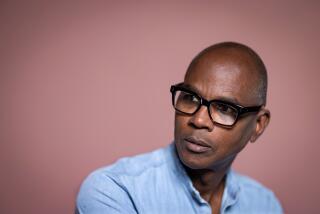ART REVIEW : KENT AT PEAK WITH LANDSCAPES
With a batch of brushes clutched in his hands, a team of huskies basking in the sun-drenched snow around him, he stands enraptured before a canvas. His subject, an icy mountain with blinding green and blue light modeling its contours, stretches across the horizon.
The artist is Rockwell Kent (1882-1971), an American painter of stylized landscapes who lived on the East Coast and sojourned in the northern wilds. He has depicted himself in “Artist in Greenland,” a 1960 canvas that offers a key to the mentality at work in “The Enkindled Eye,” a retrospective show of 80 paintings at the Santa Barbara Museum of Art through Sept. 1.
This view of the artist at work in splendid isolation exposes Kent’s attitude but it is not an altogether typical painting. He is much more likely to depict nature without human presence or restrict that presence to silent passers-by or passive observers.
A tiny Eskimo and dog team cut a hairline trail below an imposing mountain in a keystone work called “The Citadel,” and their scale proves the absolute supremacy of nature. Although Kent warmed his palette on a trip to Southern France and occasionally tackled such subjects as frolicking deer or heroically proportioned Eskimos, it was the choppy seas off the Maine coast, Alaskan glaciers and, above all, looming mountain peaks that obsessed him.
“The Enkindled Eye,” organized by museum Director Richard V. West, offers a revealing experience that fosters appreciation for the show without breeding love for the art in it. Kent is a fascinating character and a fiercely limited artist who inspires respect, admiration and affection for being so stubbornly ensconced in a period of American history.
As a conservative artist, his answer to Modernism was a simplified form of realism. As an outspoken citizen with radically leftist leanings, he stood up to McCarthy’s hearings and cooled his disenchantment with society in far-flung travels. Ever the outsider, according to West, Kent was accused of being a German spy, had his passport revoked, won the Lenin Peace Prize in 1967 and gave money to the Viet Cong. Nearly a fourth of his paintings are in Soviet museums.
Kent’s exhibited art is not overtly political, but his work can be corny, awkward and bombastic. Examples of all three failings abound in Santa Barbara. He can also epitomize a distinctly American reverence for the vastness of nature as he paints dramatic monoliths and sublime vistas. His idealism is manifest in everything from weird symbolism, social realism and spineless pastoral scenes to the flinty arctic landscapes of the ‘30s that represent his finest moment.
Yet, even when his work runs a bit sappy or lugubrious, Kent’s paintings communicate through American plainspeak. Indeed, his awe-struck roughness is shared by his more graceful contemporaries, such as Arthur Dove, Georgia O’Keeffe and Edward Hopper.
In organizing the show, West said he intended to reveal the little-known paintings of an artist mainly known for his wood-engraved illustrations and to present Kent’s views of isolation in nature as a parallel to Hopper’s urban aloneness. Both points are well made, but Kent’s theatrics abruptly divorce him from Hopper’s poignant humanity.
The longings of Hopper’s self-absorbed people fill sparsely furnished rooms. In Kent’s work, it’s the landscape that reverberates: a threatening midnight-blue abyss in “House of Dread,” a ridge of blue-white sculptured cliffs in “North (Greenland),” a mystically charged sky with haloed clouds in paintings of Tierra del Fuego. West has wisely downplayed Kent’s less successful figure painting in favor of emphasizing his real strength as a landscapist.
Kent was no lyricist, no master of subtlety. He was a powerful graphic artist and a good designer who schematized the effects of light, reduced atmosphere to unmodulated expanses of opaque pigment and flattened mountains to craggy objects of worship. Though he traveled the world, his art clung to a horizon--a firm, straight line that anchors soaring peaks and ecstatic visions to solid ground.
His artistic accomplishment rises, then falls with the chronology of the exhibition. Rockwell Kent hits his stride when his art looks like his name sounds: concise, muscular and masculine. It’s art of another era, but it deserves its place there.
More to Read
The biggest entertainment stories
Get our big stories about Hollywood, film, television, music, arts, culture and more right in your inbox as soon as they publish.
You may occasionally receive promotional content from the Los Angeles Times.










